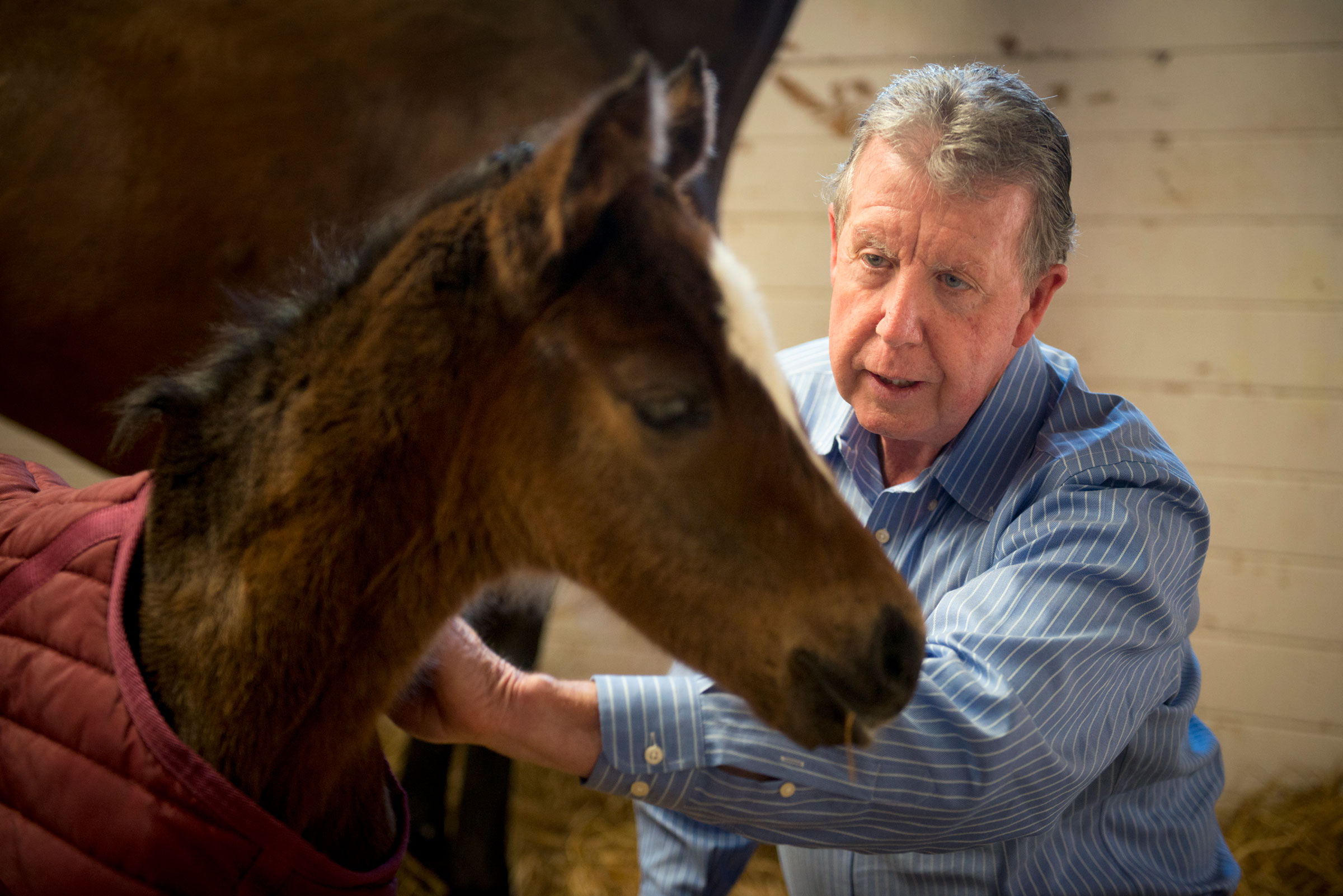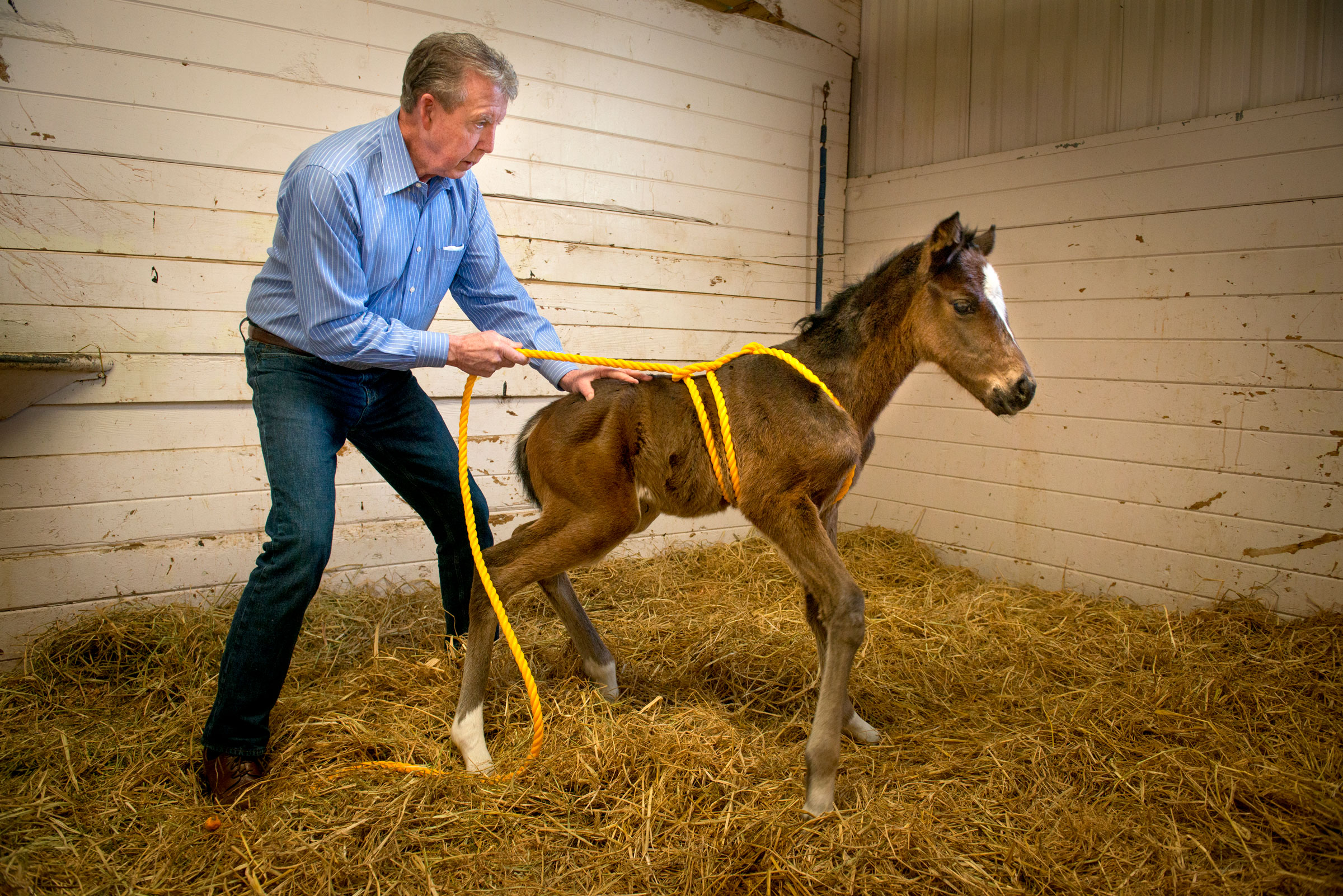
Editor’s Note: If you are a veterinarian and would like to receive a FREE quarterly EquiManagement magazine in the mail, please email Kim Brown at kbrown@equinenetwork.com. Don’t miss signing up for our newsletters on veterinary business/veterinarian wellness (EquiManagement Update) and studies related to equine health and veterinary medicine (Research Reports).
It usually evokes a sigh of relief when your client’s mare foals successfully and the newborn scrambles to its feet in the first hour or two and begins to nurse. In the course of evolution, such precocious births enabled a foal to rise in the first few hours to obtain valuable nutrition and limb coordination to enable it to run with its mother to escape predators. The scene of a foal rising to its feet—albeit often a bit clumsy at first—and latching onto the mare’s udder is heartwarming to both horse owners and their veterinarians.
But this doesn’t always happen. One syndrome that practitioners are on the lookout for is that of the “dummy” foal, one that suffers from neonatal maladjustment syndrome (NMS), which occurs in 1-2% of foal births.
While a foal affected with NMS might seem normal for a few hours or even as long as a couple of days after birth, progressive signs of nervous system dysfunction appear, with the foal becoming weaker, less interested in nursing and often no longer recognizing its dam. Response to external stimuli worsens with time, and eventually a foal can lapse into recumbency with the potential for seizures or death.
Historically, an explanation of the cause of NMS suggested some degree of oxygen deprivation and/or systemic inflammation during the period proximate to foaling—before, during or immediately after. This condition goes by other descriptive names: hypoxic-ischemic encephalopathy or perinatal asphyxia syndrome. However, as researchers seek to identify the cause, histologic examination of the brains of dummy foals does not always show evidence of hypoxia, edema or hemorrhage in brain tissue. And nearly 80% of dummy foals recover to full function with treatment, something one wouldn’t expect if there was irreparable nervous system injury.
With that in mind, clinicians John Madigan, DVM, MS, ACVIM, Monica Aleman, MVZ Cert., PhD, DACVIM, and Isaac Pessah, PhD, all of whom are well-versed in neonatal health, neurology and toxicology at the University of California, Davis, School of Veterinary Medicine, looked to other reasons for the syndrome.
Instead of neurologic changes related to hypoxia, the team identified a problem with concentrations of neuromodulating hormones (neurosteroids) of a fetus in the womb and soon after delivery. The presence of such neuroinhibitory steroids works like a sedative in conjunction with other substances (adenosine, progesterone and prostaglandins). These chemicals keep a foal quiet during gestation so it isn’t “galloping” around in the uterus, which could cause significant damage to the mare. The somewhat “sedated” state of the foal in utero also reduces oxygen needs and consumption by the foal. The foal also needs to remain immobile as it transitions through the birth canal to the outside world.
The neurosteroids, or pregnanes, are normally in high concentrations at birth and typically begin to decline steadily over the first one to two days. However, the plasma pregnane concentrations in these dummy foals remain elevated as compared to normal foals. Measurements also reveal that pregnanes of dummy foals are elevated at even higher levels than foals affected by sepsis.
The neurosteroids exert a sedative effect on the central nervous system as they pass through the blood-brain barrier. With ongoing elevated concentrations in the bloodstream and central nervous system, the affected foal fails to “wake up” and interact with the world outside the womb.
Interesting findings resulted from the UC Davis team’s test of their theory. Administration of a pregnane (allopregnanolone) to healthy neonatal foals elicited transient signs of neonatal maladjustment syndrome, such as confusion and cessation of nursing. During the experiment, EEG measurements of brain electrical impulses demonstrated that despite standing, the foals’ brains underwent slow-wave sleep. As soon as the pregnane concentrations abated, these foals returned to normal, active behavior.
Under normal foaling circumstances, pressure exerted as the foal passes through the birth canal signals a decrease in neurosteroid levels. A foal born to a mare through cesarean section, or one that passes quickly through the birth canal without being subject to normal uterine contractions and pressure, is more at risk of developing NMS. These individuals retain elevated neurosteroid concentrations in the bloodstream because of a lack of signaling by pressure in the birth canal.

This revelation by the UC Davis veterinarians about signals within the birth canal stimulated them to mimic physical compression of the birth canal through the use of ropes around the foal’s thorax. The foal is fitted with a rope harness. Gentle pressure causes the foal to lie down and enter into a somnolent state. Rope pressure is sustained for about 20 minutes, which is comparable to the time of second-stage labor as a foal passes through the birth canal in a normal delivery. This apparently signals the foal’s system to awaken, along with a hormonal surge from the hypothalamicpituitary-adrenal axis that down-regulates production of pregnanes.
Once the rope pressure is released, the dummy foal immediately converts into an aroused, nursing foal engaged with its surroundings. If done properly, the foal experiences no adverse effects from the procedure.

There are some caveats suggested in Madigan’s Manual of Equine Neonatal Medicine to achieve the best and safest results:
- The foal must be younger than 3 days old, and it works best if the foal is younger than 24 hours old.
- This is only used on foals that have stood up prior to showing signs of NMS.
- This is not to be used on a foal with respiratory distress, shock, sepsis, rib fracture, prematurity or congenital anomalies.
- A practitioner should be skilled in the procedure, and it should be performed only following a thorough physical examination of the neonate.
- Monitoring the foal following the procedure is important.
The foal squeeze is performed in a softly bedded area, such as a stall. Supplies include a soft, 5/8-inch- to 3/4-inch-diameter rope of 16-18 feet in length that slides easily. Ideally, pressure exerted on the rope harness amounts to 10-20 pounds, which can be measured using a luggage scale pressure gauge for safety. Video demonstrations can be viewed in Madigan’s digital book at equineneonatalmanual.com/foalsqueezing.
Detailed instructions with photos of the technique are available from UC Davis here.
You can see a video from UC Davis at http://ucdavis.edu/ucdavis-today/2015/february/03-foals.html.
Editor’s Note: If you are a veterinarian and would like to receive a FREE quarterly EquiManagement magazine in the mail, please email Kim Brown at kbrown@equinenetwork.com. Don’t miss signing up for our newsletters on veterinary business/veterinarian wellness (EquiManagement Update) and studies related to equine health and veterinary medicine (Research Reports).
Survey Results
Aleman and Madigan reported on a survey offered to equine veterinarians from September 2015 to April 2016. The survey asked about veterinary observations on NMS foals treated with medical therapy and the foal squeeze method.
The survey asked: “Does the use of the squeeze procedure modify recovery time from NMS compared to conventional therapies?” [Aleman, M.; Weich, M.; Madigan, J.E. Survey of Veterinarians Using a Novel Physical Compression Squeeze Procedure in the Management of Neonatal Maladjustment Syndrome in Foals, Animals, Sept 2017].
Of the 51 respondents, 44 were veterinarians. Results were tabulated for 195 foals, with 87 having receiving the squeeze procedure within 24 hours of birth; the other 108 were medically treated without the squeeze.
Of those squeezed, about 67% (58) were squeezed only once; about 27% (23) were squeezed twice; and about 7% (6) were squeezed more than twice.
The results stated: “Foals that received the squeeze procedure with or without medical therapy were 3.7 times more likely to recover faster than foals that did not receive a squeeze. Foals that were squeezed were 15.1 times more likely to recover in less than one hour than foals that were not squeezed. Foals receiving only squeeze treatment were 17.5 times more likely to recover within the first 24 hours than foals treated with only medical treatment.”
The survey reported that 12% of all foals and 14% of squeezed foals did not recover. While recovery rates were similar— 86% vs. 87%—between squeezed and non-squeezed foals, the squeeze method significantly hastened the time to full recovery.
Take-Home Message: Potential Impact of NMS
NMS is a terrifying situation for a breeder, because it poses a risk of loss of the foal, along with intense treatment and expense. An affected foal is nursed in an intensive care unit with bottle and tube feeding and medications around the clock. The process of recovering might take a week or more. While 12- 20% of foals don’t recover despite heroic efforts, many of the more than 80% that do might not, in fact, need this level of expensive and drawn-out care if their problems are related to a lack of appropriate signaling as they passed through the birth canal.
Equine practitioners are familiar with the sudden relaxation of a foal when it is “squeezed” in a person’s arms to hold it for restraint with one arm around the chest and another encircling the foal’s butt. This phenomenon reminds veterinarians just how sensitive foals are to squeeze pressure.
The Madigan Foal Squeeze Procedure achieves an appropriate signaling to a foal’s central nervous system to awaken it. The technique is a godsend for rapidly achieving recovery in susceptible foals. It costs little and takes little time. There is no doubt that witnessing an NMS foal responding to this procedure elicits huge sighs of relief by all involved.
An Aside: A Comparison to Autism
This research and solution to a difficult problem has exciting promise for human medicine. Similar to the behavior of dummy foals, autistic children are also detached in their interaction with the environment and stimuli.
At the 2014 AAEP Convention in Salt Lake City, while discussing this novel approach to NMS in foals, Madigan pointed out that spontaneous recoveries of human infants have occurred when a sick newborn baby is placed in the firm embrace of a parent’s arms.
In other cases, especially in premature births, a process referred to as “kangaroo care” swaddles the child in a blanket and provides skin-to-skin contact with its mother. This might induce physiologic signals similar to how an infant “feels” in the womb. Kangaroo care causes a baby’s heart rate to stabilize, while sleep improves and agitation lessens. The ultimate positive effects echo results from the squeeze-induced stimulation now practiced in NMS foals.
Ongoing research by UC Davis’ Comparative Neurology Research Group in collaboration with researchers at the Stanford School of Medicine is examining the effects of persistent levels of neurosteroids in human youngsters as a potential cause of autistic spectrum disorder.
Editor’s Note: If you are a veterinarian and would like to receive a FREE quarterly EquiManagement magazine in the mail, please email Kim Brown at kbrown@equinenetwork.com. Don’t miss signing up for our newsletters on veterinary business/veterinarian wellness (EquiManagement Update) and studies related to equine health and veterinary medicine (Research Reports).









